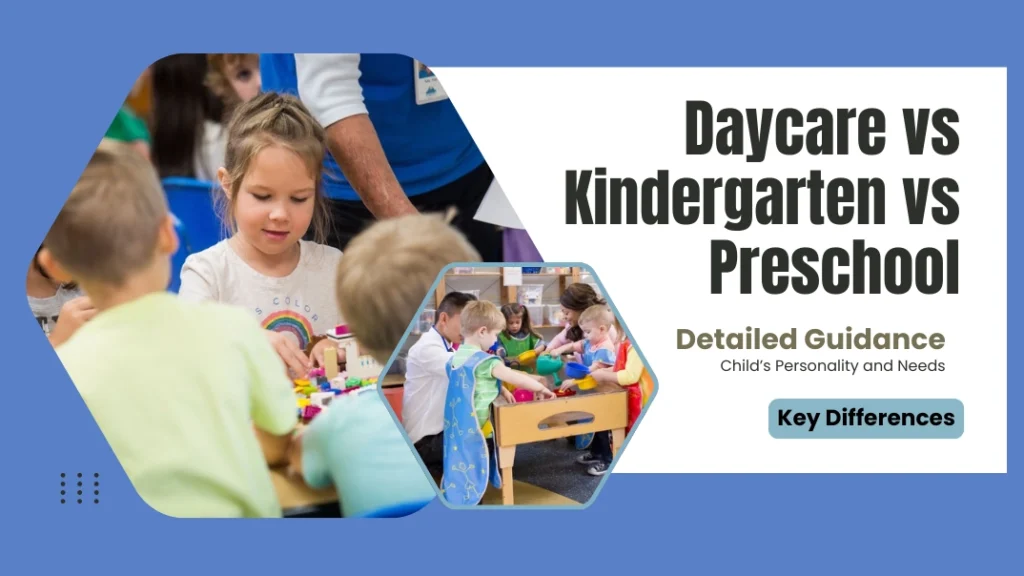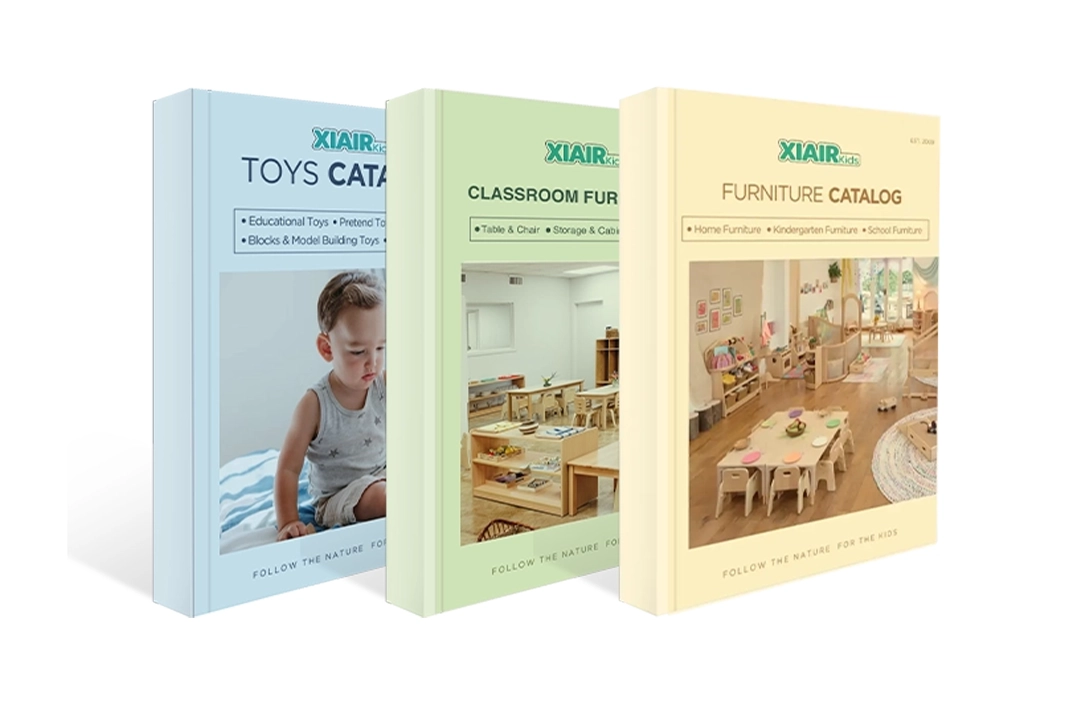Making decisions about your child’s early education can feel overwhelming. Should you choose daycare, preschool, or kindergarten? These terms might seem similar but represent distinct early childhood care and education approaches. Understanding the differences between daycare vs kindergarten vs preschool is essential for finding the right fit for your child.
This guide will explore the unique features, benefits, and differences of daycare, kindergarten, and preschool, helping you make an informed choice. Whether your child is an infant needing full-time daycare, a toddler ready for preschool, or a 5-year-old preparing for kindergarten, knowing the ins and outs of these programs ensures your child’s needs are met at every stage of development.
Why Does This Choice Matter?
Each program—daycare, preschool, and kindergarten—is designed to meet specific developmental milestones. Choosing the right one can impact your child’s learning, social skills, and confidence. Here are some key questions parents often ask when comparing daycare vs kindergarten vs preschool:
- Does my child need preschool before starting kindergarten?
- Is daycare more flexible than preschool for working parents?
- What academic and social skills are taught in kindergarten?
These questions highlight the importance of aligning your choice with your child’s age, readiness, and family needs. For instance:
- A toddler might thrive in a daycare setting focused on care and play.
- A 4-year-old might benefit more from preschool programs designed to prepare them for kindergarten.
By understanding the differences among daycare vs kindergarten vs preschool, you can ensure your child has a positive and enriching early education experience. you’re child’s age, readiness, and personality. For instance, a toddler might thrive in a daycare setting emphasizing care and play, while a 4-year-old might benefit more from pre-kindergarten programs focused on school readiness.
How Are Daycare, Preschool, and Kindergarten Different?
| Program | 연령대 | Primary Purpose | Schedule |
|---|---|---|---|
| 어린이집 | 0–5 years | Supervision, care, and basic developmental activities | Flexible, year-round availability |
| 취학 전의 | 2–4 years | Early learning through structured play and socialization | Half-day or full-day programs |
| 유치원 | 5~6년 | Formal education focusing on literacy, math, and readiness | School-year calendar |
Understanding these differences can help you align your decision with your family’s needs, whether you prioritize flexibility, socialization, or academic preparation.
What Will You Learn in This Guide?
By the end of this guide, you’ll know:
- The critical differences between daycare, preschool, and kindergarten.
- The benefits and challenges of each program.
- Practical tips for choosing the right option based on your child’s age, personality, and development.
Now, let’s dive deeper into each option, starting with daycare.
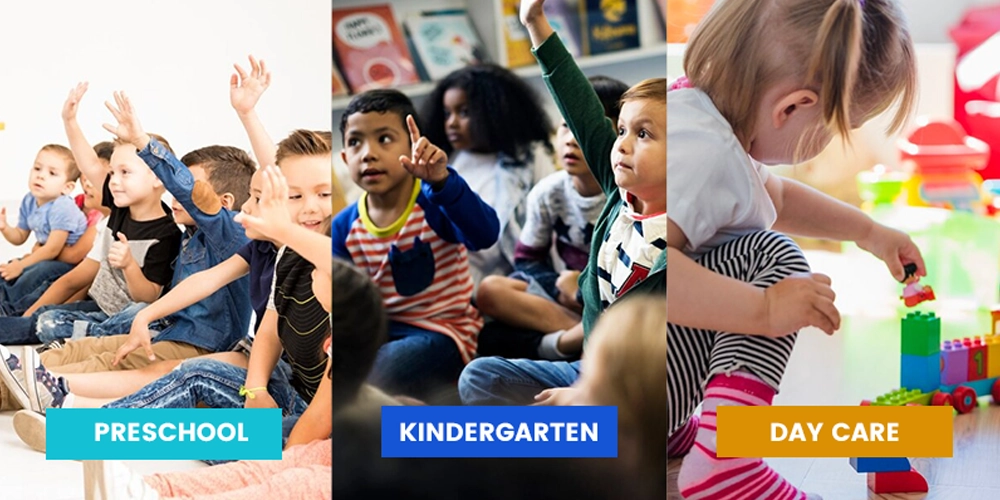
What is Daycare?
Daycare is one of the most popular options for parents seeking reliable childcare. Designed to provide a safe and nurturing environment for children, daycare focuses on care, play, and early developmental activities. It is ideal for working families who need flexible, full-day, or part-day care for children ranging from infants to pre-kindergarten age.
Definition of Daycare (daycare meaning)
Daycare is a childcare service where children are supervised in a group setting during the day. Unlike preschool or kindergarten, daycare centers prioritize care and social interaction over structured academic learning.
Daycare bridges home care and formal education, preparing children for more structured environments like preschool and kindergarten.
Critical Characteristics of Daycare:
- 연령대: From newborns to pre-kindergarten (0–5 years old).
- 목적: Providing a nurturing and safe space for children to grow socially and emotionally.
- Settings can range from small-scale home daycare setups to extensive center daycare facilities.
Center Daycare vs Home Daycare: Key Differences
Daycare services are typically offered in two primary forms: center-based daycare and home-based daycare. While both options provide care for children, they differ significantly in environment, curriculum, and flexibility.
| 특징 | Center Daycare | Home Daycare |
|---|---|---|
| 환경 | Professional facilities with age-specific classrooms | A caregiver’s home with a more intimate, personal atmosphere |
| Group Size | Larger groups, often divided by age | Smaller groups with mixed-age children |
| Curriculum | Less structured, focuses on nurturing and primary care | Often more affordable, depending on the location |
| 비용 | Generally higher, reflecting professional resources | Fixed hours may include aftercare options |
| Schedule | Fixed hours, may include aftercare options | Flexible, based on caregiver availability |
Choosing Between Center Daycare and Home Daycare
- Center daycare suits families seeking structured activities and a professional environment.
- Home daycare is ideal for parents who prefer a homier, less formal setting.
Daycare for 4-Year-Olds: Is It Suitable?
Daycare programs for 4-year-olds are specifically tailored to meet the developmental needs of children transitioning into more structured educational environments. While preschool or pre-kindergarten focuses on academics, daycare for 4-year-olds balances care, play, and early learning.
Signs That Daycare Is a Good Fit for 4-Year-Olds
- Flexible Schedules: Daycare offers longer hours than traditional preschools, making it convenient for working parents.
- Play-Based Learning: Children develop creativity, problem-solving, and teamwork through unstructured and structured play activities.
- Preparation for Preschool and Kindergarten: Many daycare programs for 4-year-olds integrate pre-academic concepts like recognizing numbers and letters, helping children prepare for preschool or pre-k.
However, parents seeking more focused academic preparation might find pre-kindergarten or preschool daycare programs more suitable for their children.
Typical Daily Activities in Daycare (play-based daycare)
Daycare schedules are carefully planned to keep children engaged, comfortable, and active throughout the day. Here’s a sample daily schedule for a daycare center catering to multiple age groups:
| Time | 활동 | 목적 |
|---|---|---|
| 8:00 AM – 9:00 AM | Arrival and free play | Its helps children settle into the environment and explore freely. |
| 9:00 AM – 10:00 AM | Circle time and storytelling | Encourages listening skills and group participation. |
| 10:00 AM – 11:00 AM | Arts and crafts or sensory activities | Develops creativity and fine motor skills. |
| 11:00 AM – 12:00 PM | 야외 놀이 | Promotes physical activity and teamwork. |
| 12:00 PM – 1:00 PM | Lunch and quiet time | Provides nourishment and rest for young children. |
| 1:00 PM – 3:00 PM | Nap time or quiet activities | Ensures emotional regulation and recharges energy. |
| 3:00 PM – 5:00 PM | Structured play and pickup | Combines learning with social interaction to wrap up the day. |
This balanced approach helps children develop socially, emotionally, and cognitively while giving parents peace of mind.
Benefits of Sending Your Child to Daycare (Early Day Daycare)
Daycare offers more than just supervision—it actively supports your child’s growth through socialization and early learning activities.
Critical Benefits of Daycare:
- 사회 개발
- Interaction with peers helps children develop teamwork, empathy, and communication skills.
- Group settings teach children how to share, cooperate, and resolve conflicts.
- Flexibility for Parents
- Most daycare centers operate year-round, including summers and holidays, making them ideal for parents with full-time jobs.
- Options like drop-in daycare or long daycare provide flexibility for families with unpredictable schedules.
- Preparation for Preschool and Kindergarten
- Many daycare centers integrate pre-academic concepts such as letters, colors, and counting into daily routines.
- This prepares children for smoother transitions into pre-k, preschool, or kindergarten.
- Safety and Supervision
- Licensed daycare centers follow strict safety regulations, ensuring children are cared for by trained professionals.
What Are Creches? Understanding Their Role
A creche, often associated with the term daycare, is a childcare facility that provides short-term or full-day care for children, typically in a structured environment. The term “creche” is more commonly used in some countries, such as the UK, while in others, the term daycare is more familiar.
Creches cater to children from infancy to pre-kindergarten age and often focus on supervision, basic developmental activities, and ensuring a safe space for young children. They serve a role similar to that of home daycare or center daycare. Still, they may be more minor or operate within larger organizations, such as companies or community centers.
Key Features of Creches
- Short-Term Care: Many creches are designed to offer flexible, drop-in childcare services for busy parents.
- 안전에 집중하다: Like daycare, creches emphasize providing a safe and nurturing environment.
- Basic Developmental Activities: Storytelling, sensory play, and music time are everyday activities in creches.
Creches vs Daycare: Are They the Same?
While creches and daycare overlap in many ways, creches are often smaller, more informal setups, whereas daycare centers tend to have more structured programs.
| 측면 | Creches | Daycare Centers |
|---|---|---|
| Duration | Often short-term or drop-in care | Full-day or extended care |
| 위치 | Frequently found in workplaces or community centers | Standalone facilities or homes |
| 연령대 | Primarily infants and toddlers | Infants to pre-kindergarten age |
Private Daycare vs Public Options
Parents often have to decide between private and public options when choosing a daycare facility. Both have pros and cons, depending on your family’s budget, location, and priorities.
| 측면 | Private Daycare | Public Daycare |
|---|---|---|
| 비용 | Higher fees due to smaller class sizes and extra amenities | More affordable, subsidized by government funds |
| Quality | Often includes specialized programs and better resources | Can vary greatly based on location and funding |
| Availability | Can vary significantly based on location and funding | May have more availability but with larger groups |
| 유연성 | Customizable schedules | Fixed hours and policies |
| Curriculum | May include advanced educational activities | Focused more on care and basic development |
Who Should Choose Private Daycare?
- Families who can afford higher fees and want smaller class sizes.
- Parents seek premium facilities with specialized programs (e.g., language immersion or advanced learning activities).
Who Benefits from Public Daycare?
- Families seeking affordable childcare.
- Parents who value diversity and more significant group interaction for their children.
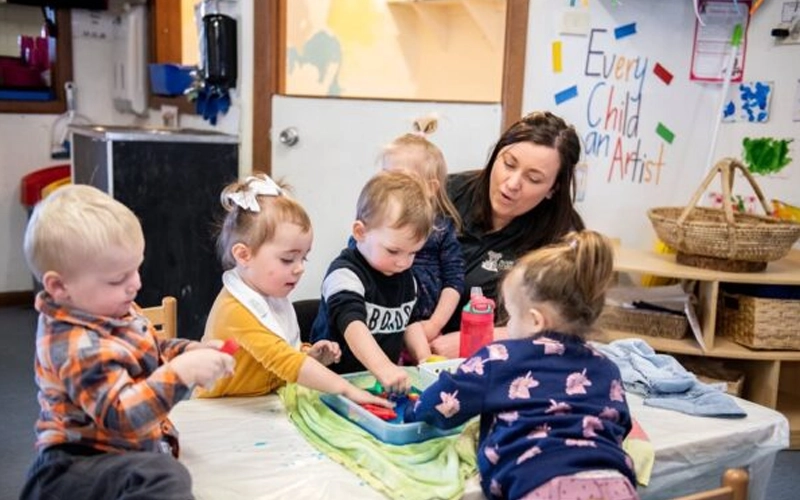
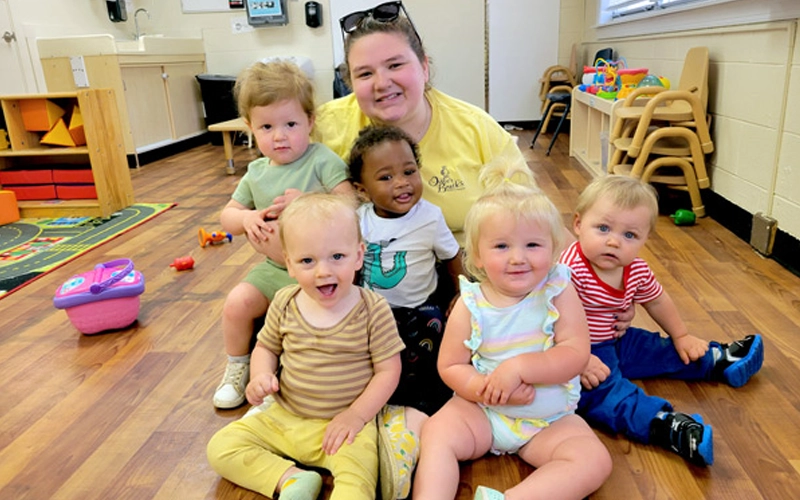
What is Kindergarten?
Kindergarten is a critical milestone in early childhood education. Designed for children aged 5 to 6, it is often considered the bridge between preschool and formal elementary school. While preschool focuses on play-based learning and foundational skills, kindergarten introduces structured academic learning alongside social and emotional development. For many families, understanding the differences between kindergarten vs preschool and how kindergarten aligns with their child’s developmental needs is crucial.
What Age is Kindergarten? (what age is kindergarten)
유치원 programs are generally designed for children aged 5 to 6 years, though age requirements can vary. Some schools also offer transitional programs like pre-kindergarten, which cater to 4-year-olds who are almost ready for kindergarten but need more preparation.
- In most regions, kindergarten is the first formal step in the education system.
- While the typical starting age is 5, some programs may allow younger children if they demonstrate readiness.
- For children not quite ready, pre-kindergarten age programs provide an opportunity to develop social and academic skills before kindergarten.
Parents often ask, “What age is pre-k compared to kindergarten?” The answer depends on the program, but pre-k generally serves children aged 4 to 5, while kindergarten focuses on 5- and 6-year-olds.
Kindergarten vs Preschool: Key Differences
Choosing between kindergarten vs preschool can be challenging for parents. Both options support early childhood education but differ significantly in structure, learning objectives, and readiness levels.
| 측면 | 취학 전의 | 유치원 |
|---|---|---|
| 연령대 | Typically 2 to 4 years | Full-day follows the academic calendar |
| 집중하다 | Play-based learning, creativity, and socialization | Academic readiness, literacy, and numeracy |
| 학습 스타일 | Informal, emphasizing exploration and curiosity | Formal, focusing on structured learning goals |
| Schedule | Flexible hours (half-day or full-day) | Full-day, follows the academic calendar |
| Skills Taught | Basic social, motor, and language skills | Generally, 5 to 6 years |
Preschool provides children with their first exposure to group learning, whereas kindergarten is more structured, preparing children for elementary school.
Skills Children Learn in Kindergarten
Kindergarten lays the foundation for academic and social success. The curriculum emphasizes critical developmental areas:
Academic Skills
- Reading Readiness: Recognizing letters, phonics, and forming simple words.
- Numeracy: Counting, essential addition, subtraction, and understanding shapes and patterns.
- 과학: Introduction to weather, plants, animals, and seasons.
Social and Emotional Skills
- Teamwork: Children learn to collaborate in groups, take turns, and respect others.
- Emotional Regulation: Activities like role-playing help children express feelings and solve conflicts.
Life Skills
- Time Management: Adapting to a daily schedule with specific times for learning, play, and rest.
- Responsibility: Understanding rules and completing assigned tasks.
For parents comparing daycare vs kindergarten vs preschool, it’s essential to note that kindergarten has a much stronger academic focus than daycare and builds on the basic skills taught in preschool.
Is Kindergarten Part of Elementary School?
Kindergarten is often considered the first step in the formal education system. It is a transitional year, blending play-based activities with academic instruction to prepare children for first grade.
- 체계적인 커리큘럼: Aligns with state or national academic standards.
- 교실 환경: Mirrors the setup of higher grades, helping children adapt to a formal school environment.
- Focus on Readiness: Ensures children meet elementary school’s essential academic and social benchmarks.
Unlike daycare or preschool, kindergarten is a mandatory part of formal schooling in many regions.
Kindergarten vs Pre-K: How They Prepare Kids Differently
While kindergarten and pre-kindergarten prepare children for future education, they serve slightly different purposes.
| 측면 | Pre-Kindergarten (Pre-K) | 유치원 |
|---|---|---|
| 연령대 | 4 to 5 years | 5 to 6 years |
| Curriculum Focus | Play-based learning, social and motor skills | Literacy, numeracy, and early problem-solving |
| Schedule | Part-day or full-day | Full-day, academic year schedule |
| Goal | School readiness, with a focus on socialization | Elementary school readiness, emphasizing academics |
Pre-kindergarten introduces routines like circle time and group play, while kindergarten builds on these experiences to develop critical academic and life skills.
Kindergarten Daycare: When Do Parents Choose Both?
Some parents choose a hybrid approach by combining daycare with kindergarten. This is especially common for families who need after-school care or flexible schedules.
Benefits of Combining Daycare and Kindergarten:
- Extended Hours: Kindergarten often ends earlier than the typical workday, and daycare provides coverage for working parents.
- Social Opportunities: Interaction with peers in both settings enhances a child’s social development.
- Academic Support: Some daycare programs offer homework assistance or enrichment activities.
For families navigating daycare vs kindergarten vs preschool, understanding how these options can complement each other helps create a well-rounded experience for the child.

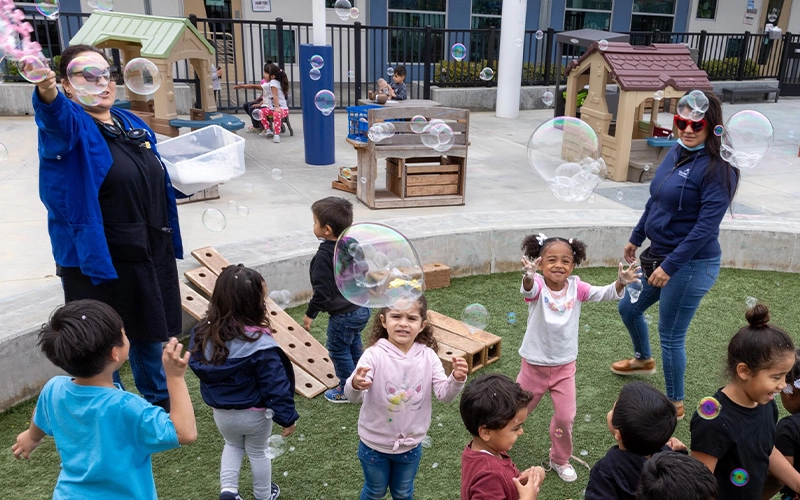
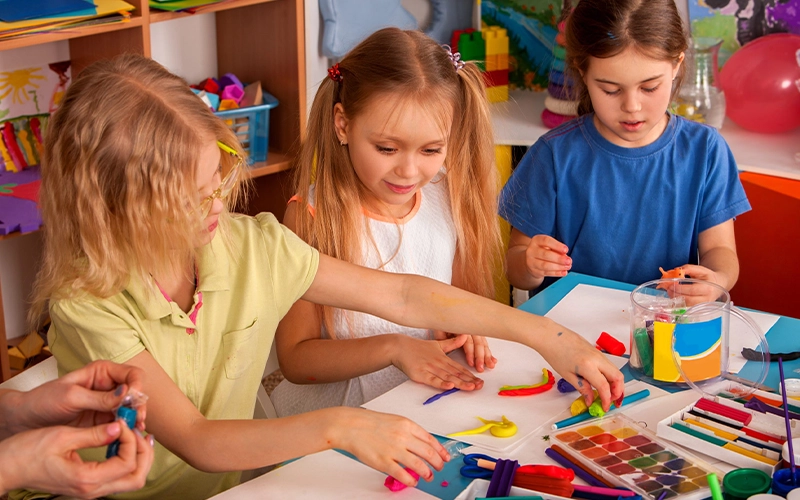
What is Pre K?
Pre-kindergarten, commonly called pre-k, is an early childhood education program to prepare children for kindergarten. As a transitional stage between preschool and kindergarten, pre-k focuses on school readiness by combining play-based learning with structured academic activities.
Parents often wonder, “Is pre-k the same as preschool?” While both programs emphasize early learning, pre-k is more advanced, catering to children closer to kindergarten age.
Pre-K Age Range: What Age is Pre K?
Pre-K typically ranges from 4 to 5 years old, making it the ideal option for children about to enter kindergarten. Programs are specifically designed to address the developmental needs of this age group, focusing on skills like:
- 인지 발달: Problem-solving, reasoning, and early literacy.
- 사회적 기술: Sharing, teamwork, and effective communication.
- Emotional Readiness: Building confidence and managing emotions in a classroom setting.
For parents comparing daycare vs kindergarten vs preschool, pre-k is an essential stepping stone for children ready to transition from unstructured play to more formal academic learning.
What Does Pre-K Stand For? (pre k meaning)
Pre-K stands for pre-kindergarten, highlighting its role as a preparatory stage before children enter kindergarten. Unlike preschool, which serves younger children (typically 2-4 years old), pre-k is tailored for older kids ready to develop the skills needed for formal schooling.
Why is Pre-K Important?
- It bridges the gap between play-focused learning in preschool and structured academics in kindergarten.
- Pre-K helps children develop routines and adapt to group settings, smoother the transition to kindergarten.
How Pre-K Prepares Kids for Kindergarten
Pre-K programs equip children with the academic, social, and emotional skills they need to succeed in kindergarten.
| Skill Category | Pre-K Activities | How It Helps in Kindergarten |
|---|---|---|
| 학업 준비성 | Learning letters, numbers, and shapes | Builds foundational literacy and numeracy skills |
| 사회적 상호 작용 | Group play, sharing, and turn-taking | Encourages teamwork and respect for others |
| 정서 발달 | Role-playing, managing transitions | Helps children adapt to new environments |
| 독립 | Completing simple tasks, like cleaning up after activities | Encourages responsibility and self-reliance |
Pre-K emphasizes routines like circle time and structured lessons to help children develop the discipline needed for the kindergarten classroom.
Difference Between Pre K and Preschool
While pre-kindergarten and preschool share similarities, they cater to different age groups and readiness levels.
| 측면 | 취학 전의 | Pre-Kindergarten (Pre-K) |
|---|---|---|
| 연령대 | 2 to 4 years old | 4 to 5 years old |
| 집중하다 | Socialization, play-based learning | Academic readiness, structured activities |
| Curriculum | Emphasizes creativity and exploration | Combines play with academic preparation |
| Readiness Level | First exposure to group learning | Prepares children for kindergarten |
| Schedule | Half-day or flexible programs | Full-day programs aligned with kindergarten hours |
Key Takeaway: Preschool introduces children to group settings, while pre-k ensures they are ready to meet kindergarten’s academic and social challenges.
Pre-K vs Head Start: Are They the Same?
Pre-K and Head Start are not the same, though they share some similarities.
- Pre-K programs are state-funded or private initiatives aimed at preparing children for kindergarten.
- Head Start, on the other hand, is a federally funded program designed to support low-income families by providing children with early education and health services.
Both programs focus on early childhood development, but their target audiences and funding sources differ.
Is Pre-K the Same as Preschool?
Pre-K is not the same as preschool, though they overlap in purpose.
- 취학 전의 introduces basic concepts like shapes, colors, and simple social skills.
- Pre-K builds on these concepts, focusing more on academic preparation and group learning.
If you’re comparing daycare vs kindergarten vs preschool, it’s essential to see pre-k as the bridge that connects these stages, giving children the tools they need to succeed in a formal school setting.

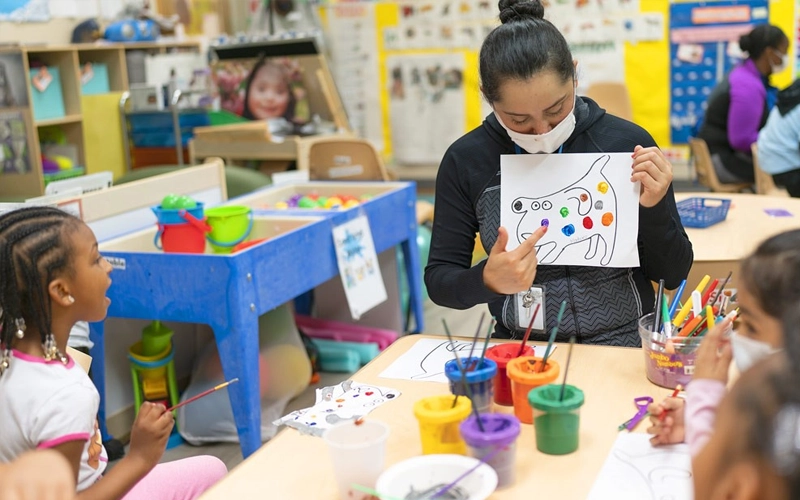
What is Preschool?
Preschool, or early childhood education, is essential for children aged 2 to 4. It emphasizes structured play, socialization, and early academic skills, preparing children to transition to pre-kindergarten and kindergarten. For parents comparing daycare vs kindergarten vs preschool, understanding the unique role of preschool is critical to making the best choice for their child.
Defining Preschool: What Age is Preschool? (preschool age)
Preschool typically serves children aged 2 to 4 years. This period is often called the “early childhood years,” when children are most receptive to learning through play and exploration.
| 연령대 | Developmental Focus in Preschool |
|---|---|
| 2 to 3 Years Old | Basic social skills, such as sharing and interacting with peers. |
| 3 to 4 Years Old | Introduction to academic concepts, including letters, numbers, and shapes. |
| 4+ Years Old | Prepares children for pre-kindergarten and kindergarten through structured learning activities. |
For families evaluating preschool vs daycare, the primary distinction lies in the age group served and the focus on academic readiness.
Difference Between Daycare and Preschool (daycare & preschool)
Parents often compare daycare & preschool to determine the right fit for their child. While both options cater to young children, their purpose, curriculum, and schedule differ significantly.
| 측면 | 어린이집 | 취학 전의 |
|---|---|---|
| 연령대 | Infants to pre-kindergarten age (0–5 years) | 2 to 4 years old |
| Primary Focus | Supervision, care, and basic developmental activities | Early learning, structured play, and socialization |
| Schedule | Full-day, flexible hours | Often half-day, aligned with school calendars |
| Curriculum | Minimal academic content | Introduces early academic skills like counting and letter recognition |
| 환경 | Care-oriented | Learning-oriented |
When deciding between daycare vs preschool, parents should consider their child’s age, developmental needs, and family schedule.
Preschool vs Pre K: How Do They Compare? (prek vs preschool)
Preschool and pre-kindergarten (pre-k) are often seen as overlapping programs but serve slightly different purposes. Preschool introduces children to group learning environments, while pre-k focuses on preparing children for the academic structure of kindergarten.
| 측면 | 취학 전의 | Pre-Kindergarten (Pre-K) |
|---|---|---|
| 연령대 | 2 to 4 years old | 4 to 5 years old |
| 집중하다 | Play-based learning | Academic readiness, structured activities |
| Skills Taught | Social skills, motor skills, language development | Literacy, numeracy, and classroom behavior |
| Schedule | Often half-day | Full-day, aligned with kindergarten schedules |
For families navigating daycare vs kindergarten vs preschool, pre-k acts as the bridge between preschool and kindergarten, offering a more advanced curriculum than preschool.
Structured Learning in Preschool: Key Benefits (early childhood preschool)
Preschool is critical for early childhood development, providing a structured environment that fosters learning through play.
Critical Benefits of Preschool:
- 사회적 기술: Group play and storytelling teach children to share, cooperate, and communicate effectively.
- Academic Exposure: Children are introduced to foundational concepts like letters, numbers, and shapes, preparing them for pre-kindergarten and kindergarten.
- Routine and Discipline: Preschool introduces structured schedules, helping children adapt to routines and classroom rules.
- Creativity and Exploration: Art projects, music time, and sensory activities stimulate creativity and problem-solving skills.
For families considering daycare vs preschool, the structured curriculum offers a distinct advantage for children ready to transition to academic learning.
Preschool Daycares: What They Offer (preschool daycare)
Preschool daycare combines the features of traditional daycare with the educational focus of preschool, making it a popular choice for working parents.
What Preschool Daycares Provide:
- Flexible Hours: Full-day programs that accommodate parents’ work schedules.
- Blended Learning: A mix of care services and academic activities like storytime and counting games.
- 사회적 상호 작용: Opportunities for children to play and learn alongside peers.
For families balancing work and their child’s education, preschool daycare offers the best of both worlds, bridging the gap between daycare and preschool.
Do You Have to Go to Preschool Before Kindergarten?
While attending preschool is not mandatory in most regions, it is highly recommended for children preparing to enter kindergarten. Preschool provides a strong foundation in the following:
- Academic Skills: Early exposure to letters, numbers, and problem-solving.
- Social Readiness: Learning how to interact with peers in a group setting.
- 독립: Encouraging self-help skills like packing their belongings and following instructions.
Families comparing preschool and kindergarten should consider the benefits of preschool in ensuring a smoother transition to formal schooling.
Preschool always precedes kindergarten as the foundation for a child’s academic journey. The typical sequence is:
- Daycare or Home Care: For infants and toddlers needing supervision.
- 취학 전의: For children aged 2 to 4, focusing on socialization and early learning.
- 유치원: For 5- to 6-year-olds, emphasizing academic readiness and structured learning.
Children gain the skills they need to excel in kindergarten by attending preschool, making it an essential step in their early education.

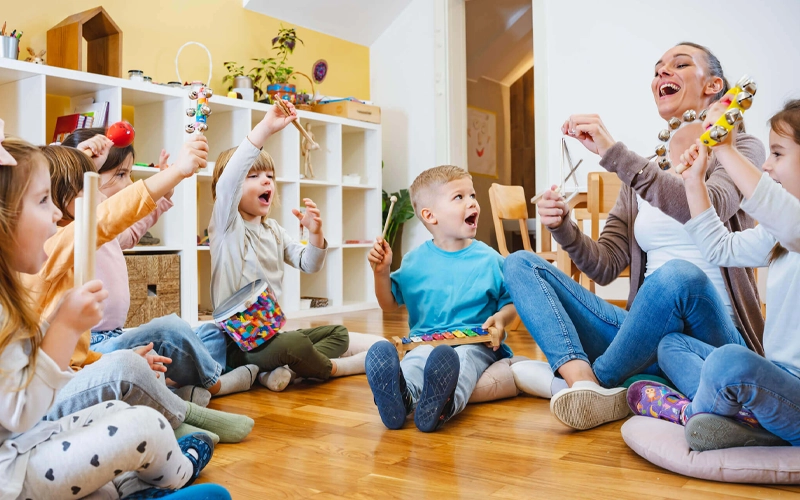
The Key Differences Between Daycare vs Kindergarten vs Preschool
When deciding between daycare vs kindergarten vs preschool, parents must evaluate how each option fits their child’s developmental stage, personality, and family schedule. While the differences might seem subtle initially, they can significantly impact a child’s learning experience and readiness for formal schooling.
Age Groups: How They Differ
- 어린이집: This option is ideal for families needing full-day supervision for children, including infants as young as six weeks old. Daycare programs are designed to offer flexible care hours, making them suitable for working parents. The primary focus here is providing a nurturing and safe environment.
- 취학 전의: Serving children aged 2 to 4 years, preschool emphasizes early academic exposure through play-based learning. It’s an excellent choice for children ready to explore social interactions and foundational concepts like numbers, shapes, and letters.
- 유치원: Designed for older children aged 5 to 6 years, kindergarten introduces structured academics like literacy, numeracy, and problem-solving. It also prepares children for the routines and responsibilities of formal schooling.
Each program caters to a specific age range and is designed to meet children’s developmental needs:
| Program | 연령대 | Primary Focus |
|---|---|---|
| 어린이집 | Infants to 5 years old | Care, social interaction, and basic activities |
| 취학 전의 | 2 to 4 years old | Play-based learning and early academics |
| 유치원 | 5 to 6 years old | Academic readiness and structured education |
Parents should evaluate their child’s current developmental stage to determine which option best supports their needs.
Preparation and Development Goals
- Daycare Goals: Daycare ensures children are safe and comfortable while supporting essential development. Activities often include free play, sensory exploration, and simple group games to encourage early social interaction.
- Preschool Goals: Preschool bridges the gap between unstructured care and academic preparation. Children develop cognitive skills and an early interest in learning through activities like storytelling, singing, and puzzles.
- Kindergarten Goals: In kindergarten, the focus shifts to achieving measurable milestones, such as reading fluency, counting, and basic writing skills. The structured curriculum also builds emotional resilience and independence, preparing children for the challenges of elementary school.
Each program has unique goals that align with a child’s age and readiness level:
| Program | Developmental Goals |
|---|---|
| 어린이집 | Provide a safe and nurturing environment; foster basic social and motor skills |
| 취학 전의 | Introduce early academic concepts; encourage creativity, socialization, and curiosity |
| 유치원 | Develop literacy and numeracy skills; build independence, responsibility, and critical thinking |
When comparing the difference between preschool and kindergarten, it’s clear that preschool introduces foundational skills, while kindergarten emphasizes mastery and readiness for advanced academics.
Schedule and Hours: Normal Daycare Hours vs Preschool (typical daycare hours)
- 어린이집: Daycare offers unmatched flexibility, with many centers open 10–12 hours daily. They cater to parents who work long or irregular hours, making daycare a lifeline for working families. Some programs also offer drop-in daycare for added convenience.
- 취학 전의: Most preschools operate on a part-day schedule, with sessions typically running for 3–4 hours in the morning or afternoon. This limited schedule aligns with the developmental needs of younger children who may need more rest during the day.
- 유치원: Kindergarten typically mirrors elementary school hours, with full-day programs becoming increasingly common. For families transitioning from preschool or daycare, these longer hours can be a significant adjustment for children.
The schedule and hours offered by each program differ significantly, often reflecting their primary purpose:
| Program | Schedule |
|---|---|
| 어린이집 | Typically open year-round, including summers and holidays; flexible hours (full-day or part-day) |
| 취학 전의 | Operates on a school-year calendar; usually part-day programs |
| 유치원 | Follows the traditional school-year schedule; full-day programs are common |
Staff and Qualifications in Each Option
- Daycare Staff: Daycare caregivers focus on ensuring children’s safety and comfort. While some caregivers have early childhood training, the primary emphasis is on nurturing rather than teaching.
- Preschool Staff: Preschool teachers often hold degrees in early childhood education. They are skilled in implementing play-based learning strategies that promote academic and social development.
- Kindergarten Staff: Teachers must hold teaching licenses and meet strict certification requirements. Their training equips them to teach core subjects like reading, math, and science while addressing the social-emotional needs of children.
| Program | Staff Qualifications |
|---|---|
| 어린이집 | Teachers with degrees in early childhood education, expertise in play-based learning and academics |
| 취학 전의 | Teachers with degrees in early childhood education; expertise in play-based learning and academics |
| 유치원 | Licensed educators with advanced training in teaching literacy, numeracy, and child development |
Parents comparing preschool and daycare difference should note that preschool staff are generally more academically focused than daycare caregivers.
꿈만 꾸지 말고, 직접 디자인하세요! 맞춤 가구에 대한 니즈를 함께 이야기 나눠요!
Play-Based vs Academic Curriculums (play-based learning)
- Daycare Curriculum: Activities like building blocks, outdoor play, and music sessions dominate daycare programs. The goal is to foster creativity and social engagement without formal academics.
- Preschool Curriculum: Preschool strikes a balance between play and learning. For example, children might explore counting through games or improve fine motor skills by coloring and crafting.
- Kindergarten Curriculum: Kindergarten shifts toward academics, with lessons focused on literacy, numeracy, and basic science concepts. Structured learning time is balanced with recess and creative activities.
| Program | 학습 접근 방식 |
|---|---|
| 어린이집 | Primarily play-based, focusing on free play and social interaction |
| 취학 전의 | Combines play-based learning with the introduction of academic concepts |
| 유치원 | Structured academic curriculum with a focus on literacy, numeracy, and problem-solving |
Potty Training
Potty training expectations differ across programs:
- 어린이집: Many centers accept children still in diapers, though some require partial potty training for older toddlers.
- 취학 전의: Most preschools expect children to be fully potty trained by the time they enroll.
- 유치원: Potty training is a mandatory requirement.
Parents comparing the difference between daycare and preschool should consider their child’s readiness for potty training, as this can affect enrollment options.
Operational Hours
The operational hours of daycare, preschool, and kindergarten differ significantly, reflecting the unique purpose of each program. Parents often weigh these options based on their family’s schedule, work commitments, and the child’s developmental readiness.
| Program | Operational Hours |
|---|---|
| 어린이집 | Typically offers full-day care, operating 8–12 hours daily to accommodate working parents. |
| 취학 전의 | Primarily provides half-day sessions, with some full-day programs available in specific locations. |
| 유치원 | Operates on a standard school schedule, typically 6–7 hours daily during the academic year. |
Daycare: Full-Day Care for Working Parents
어린이집 programs are designed to provide maximum flexibility for families. They typically operate for extended hours, often from 7:00 AM to 6:00 PM, and may even offer drop-in care for emergencies.
- Convenience for Working Families: The extended hours allow parents to manage their work schedules without worrying about early pickups or late drop-offs.
- Consistency for Children: Full-day schedules ensure children have ample time to engage in various activities, including outdoor play, group interactions, and quiet time.
- Year-Round Availability: Unlike preschool or kindergarten, daycare often operates year-round during school holidays and summer breaks.
For families deciding between daycare vs preschool, the flexibility of daycare’s full-day options is a significant advantage.
Preschool: Half-Day Options with Educational Focus
Preschool programs typically run 3–4 hours daily in the morning or afternoon. However, some locations offer full-day preschool daycare, combining educational activities with extended care hours.
Advantages of Half-Day Preschool:
- Age-Appropriate Structure: Shorter hours align with the attention spans and energy levels of younger children, ensuring they remain engaged and productive.
- Focus on Early Learning: Preschool’s half-day schedule prioritizes educational activities like storytelling, arts, and basic math or literacy lessons.
- Preparation for Kindergarten: The part-day routine helps children gradually adapt to the structure of a school day.
Parents comparing preschool daycare difference should consider whether their child thrives in a shorter, focused environment or needs the consistency of full-day care.
Kindergarten: Standard School Hours for Formal Learning
Kindergarten operates on a full-day schedule, mirroring that of elementary school. Programs usually last 6–7 hours daily, providing academic instruction, creative activities, and physical education.
Key Features of Kindergarten Hours:
- Structured Routine: The extended day allows in-depth reading, writing, and math lessons while leaving time for creative and social activities.
- Aligned with School Calendars: Kindergarten follows the academic year, with summers and holidays off, preparing children for the schedules of higher grades.
For parents evaluating daycare vs kindergarten vs preschool, kindergarten’s full-day hours mark a significant shift from the flexibility of daycare and the shorter preschool sessions.
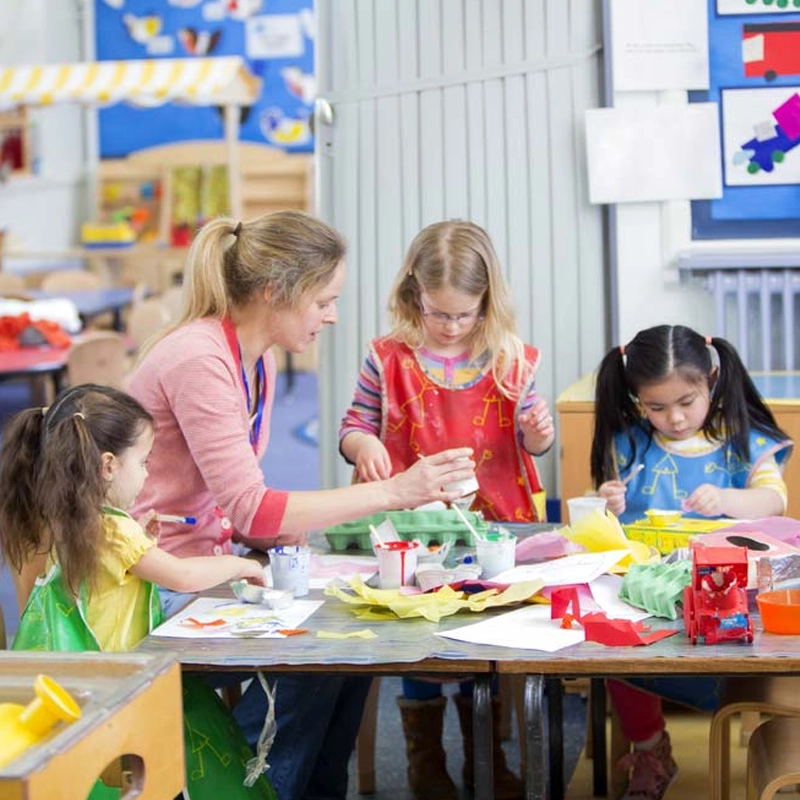
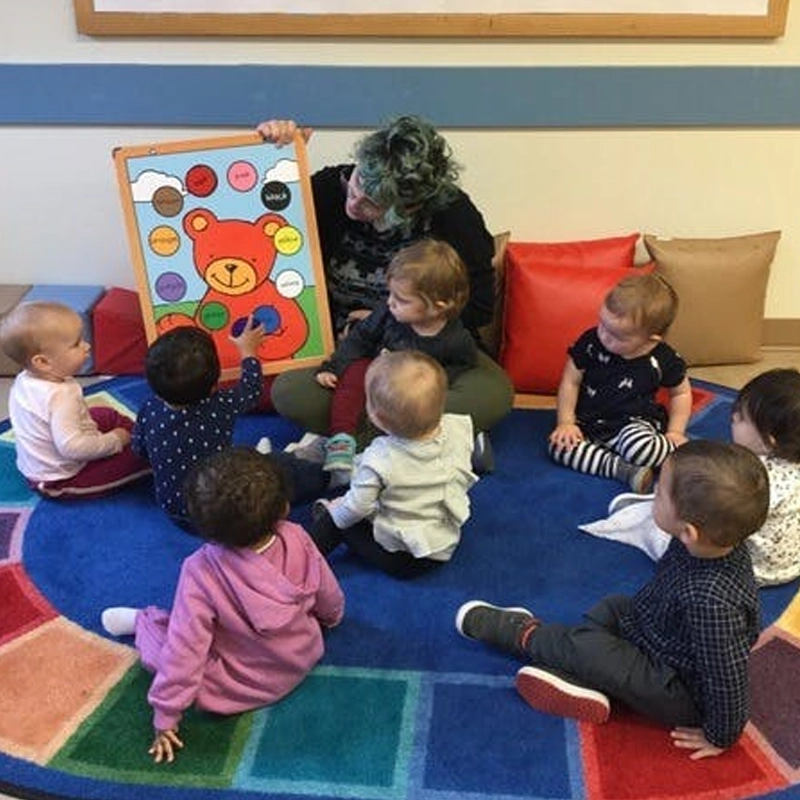
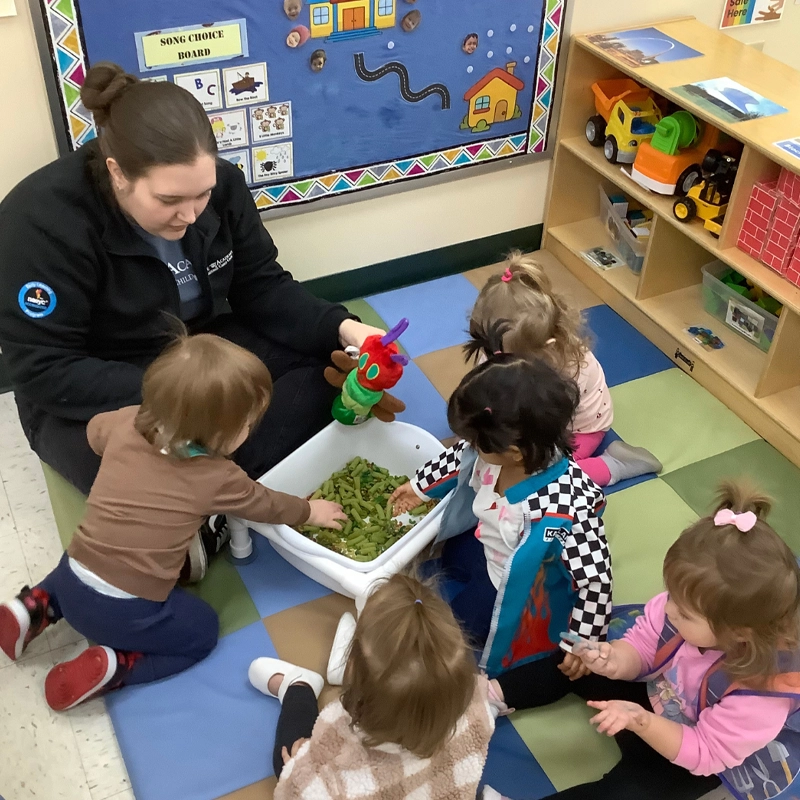
Choosing the Right Option for Your Child
Deciding between daycare, kindergarten, and preschool can feel overwhelming. Each option offers unique benefits and caters to different developmental stages, but the key is to align your choice with your child’s age, personality, and family needs. This guide will help you evaluate the differences and choose the best fit for your child’s growth.
Factors to Consider When Choosing
When comparing daycare vs kindergarten vs preschool, parents should consider the following factors:
- Age and Development
- If your child is an infant or toddler (0–2 years old), daycare is the most suitable choice due to its focus on care and flexible hours.
- Preschool introduces structured play and early learning for children aged 2–4 years.
- Children aged 5–6 years are ready for kindergarten, which emphasizes academic readiness and independence.
- Family Schedule
- 어린이집 offers full-day care with flexible hours, making it ideal for working parents.
- 취학 전의 programs are typically half-day, but some offer extended hours through preschool daycare options.
- 유치원 follows a standard school schedule, which may require additional after-school care for working families.
- Child’s Personality and Needs
- Shy children may benefit from smaller preschool settings that prioritize socialization.
- Energetic toddlers might thrive in the unstructured, play-based environment of daycare.
- Older children who show interest in reading or math will excel in kindergarten.
- Cost and Budget
- Public kindergarten is often free, while preschool and daycare costs vary significantly based on location and program type.
- Private daycare and preschool programs typically cost more due to specialized curriculums and smaller class sizes.
By carefully assessing these factors, you can identify which program aligns best with your child’s developmental stage and family needs.
Questions to Ask When Visiting Facilities
Visiting a daycare, preschool, or kindergarten facility is a critical step in decision-making. Asking the right questions ensures that the program meets your expectations and your child’s needs.
- For Daycare:
- What is the caregiver-to-child ratio?
- Are the staff trained in early childhood development and safety protocols?
- What are the hours of operation?
- For Preschool:
- Does the program follow a structured curriculum?
- What learning methods are used (e.g., play-based or academic-focused)?
- Are snacks and meals provided, and do they accommodate dietary restrictions?
- For Kindergarten:
- What academic and social skills are emphasized?
- Is there a balance between structured lessons and creative activities?
- How is parent-teacher communication handled?
By asking these questions, you’ll gain valuable insights into how each program operates and whether it fits your child well.
Daycare, Preschool, or Kindergarten: Making the Best Choice
| 대본 | Best Option |
|---|---|
| Parents with demanding work schedules | 어린이집: Flexible hours, full-day programs, year-round availability |
| Preparing a 4-year-old for kindergarten | 취학 전의: Structured learning with an academic focus |
| Transitioning to formal education | 유치원: Emphasizes literacy, numeracy, and school readiness |
| Combining care with early learning | Preschool daycare: Offers extended hours and a learning-focused environment |
Detailed Guidance:
- Choose Daycare if your child requires full-day supervision, especially during infancy or toddlerhood. Daycare provides a safe, nurturing environment with opportunities for social interaction and basic developmental activities.
- Opt for Preschool if your child is ready to explore early academic concepts and develop social skills in a structured, play-based setting. Preschool is ideal for children aged 2–4 years.
- Select Kindergarten if your child is entering the 5–6 age range and shows readiness for structured learning. Kindergarten builds the foundational skills needed for elementary school.
When evaluating daycare vs kindergarten vs preschool, parents should also consider hybrid options like preschool daycare, which blends educational activities with the convenience of extended care.
Deciding between daycare, preschool, and kindergarten depends on your child’s age, readiness, and your family’s unique circumstances.
- 어린이집 is best for flexible care and nurturing environments for younger children (0–5 years).
- 취학 전의 introduces structured learning for children aged 2–4 years, emphasizing creativity and socialization.
- 유치원 bridges the gap to formal education, preparing children aged 5–6 years for academic success.
By evaluating the differences between daycare vs kindergarten vs preschool and considering your child’s needs, you can confidently choose the right program to support their growth and development.
결론
Selecting the best option among daycare, preschool, and kindergarten is a decision that shapes your child’s early learning experiences and future success. Each program serves a unique purpose, catering to different age groups and developmental needs. Daycare is an excellent choice for younger children, offering a nurturing and flexible environment that supports working families. It prioritizes care, socialization, and basic developmental activities, making it ideal for infants and toddlers. On the other hand, preschool bridges the gap between care and education, focusing on structured play and early academics for children aged 2 to 4 years. For children ready to embrace formal schooling, kindergarten introduces a structured curriculum that builds literacy, numeracy, and problem-solving skills while fostering independence and emotional growth.
When comparing daycare vs kindergarten vs preschool, parents should evaluate their child’s age, readiness, and personality to determine the best fit. Visiting facilities, asking detailed questions, and observing classroom dynamics are critical steps to finding a program that aligns with your family’s needs. Remember that every child is unique, and the right choice will provide a safe and stimulating environment and a solid foundation for lifelong learning.
By making an informed decision, you’re setting your child on a path of growth, curiosity, and achievement. Whether it’s the flexible care of daycare, the structured play of preschool, or the academic preparation of kindergarten, each step contributes to your child’s journey toward a bright future.
